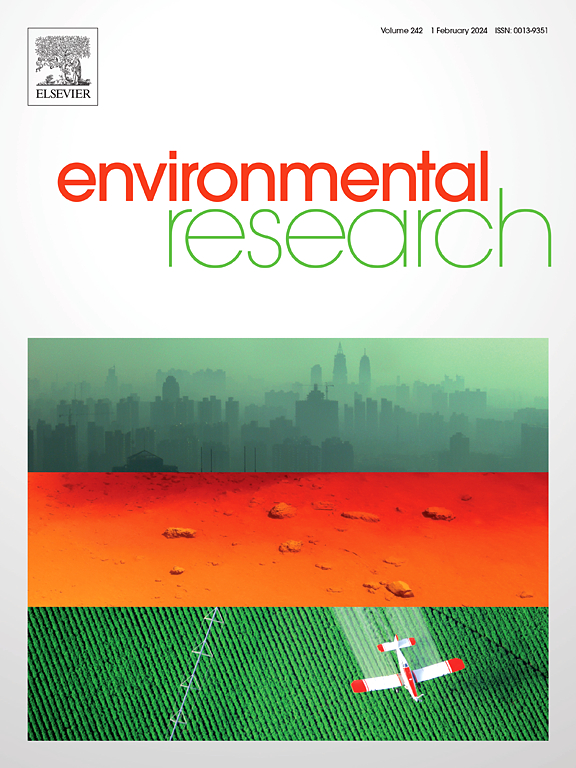中国城市不同工作场所和通勤过程中的挥发性有机化合物:不同职业的发生和健康风险
IF 7.7
2区 环境科学与生态学
Q1 ENVIRONMENTAL SCIENCES
引用次数: 0
摘要
工作场所、住所和通勤构成了人们接触空气污染物的绝大部分,但人们对它们的比例知之甚少。本研究测量了中国某特大城市各种工作场所、住宅和通勤车辆中的挥发性有机化合物(VOCs)。工作场所目标VOCs总浓度(∑VOC20) (2.56 ~ 671.69 μg/m3,几何平均值为57.32 μg/m3)显著高于住宅(18.66 μg/m3),其中商场和家具商场的浓度最高,图书馆和博物馆的浓度最低。然而,工作场所和住宅的浓度都明显低于车辆车厢(公共汽车、地铁和汽车)内的浓度(107.62 μg/m3)。主成分分析确定了工作场所挥发性有机化合物的四个主要来源:室内使用清洁和消毒剂(26%)、各种室内产品表面(23%)、家具和建筑材料内部(20%)以及室外/车辆排放(31%)。道路车辆排放是车内挥发性有机化合物的主要来源。在所有微环境中,芳烃和烷烃是主要的物种,而酯类和卤代烃则相反。工作场所挥发性有机化合物的组成特征相似,受室外污染源影响显著。司机职业的癌症和非癌症风险都大大高于其他队列。如果排除司机,职业暴露仍然是造成风险的最大因素。本研究提供了一个大型城市VOC暴露的综合评估。它强调了与交通相关的挥发性有机化合物的重大健康风险,强调了在中国城市制定减少汽车挥发性有机化合物排放战略的必要性。本文章由计算机程序翻译,如有差异,请以英文原文为准。

Volatile organic compounds in various workplaces and during commutes in a Chinese city: occurrence and health risks for different occupations
The workplace, residence, and commute constitute the vast majority of people's exposure to air pollutants, whereas their apportionment is poorly understood. This study measured volatile organic compounds (VOCs) in various workplaces, residences, and commuting vehicles in a Chinese megacity. The total concentrations of target VOCs (∑VOC20) in workplaces (2.56 − 671.69 μg/m3, geometric mean = 57.32 μg/m3), with the highest concentrations in shopping malls and furniture malls and the lowest in libraries and museums, were significantly higher than those in residences (18.66 μg/m3). However, both workplace and residential concentrations were significantly lower than those inside vehicle cabins (buses, subways, and cars) (107.62 μg/m3). Principal component analysis identified four main sources of VOCs in the workplaces: use of cleaning and disinfectant agents indoors (26 %), various indoor product surfaces (23 %), the interior of furnishings and construction materials (20 %), and outdoor/vehicle emissions (31 %). On-road vehicle emissions were the major source of in-vehicle VOCs. Aromatics and alkanes were the major species in all the microenvironments, in contrast to esters and halocarbons. Similar composition profiles of VOCs in the workplaces were found, which were significantly influenced by outdoor sources. Both the cancer and non-cancer risks for the driver occupation were substantially higher than those of other cohorts. Occupational exposure remains the largest contributor to the risks if drivers are excluded. This study provides a comprehensive assessment of VOC exposure in a megacity. It underscores significant health risks related to traffic-related VOCs, highlighting the need for strategies to mitigate vehicle emissions of VOCs in Chinese cities.
求助全文
通过发布文献求助,成功后即可免费获取论文全文。
去求助
来源期刊

Environmental Research
环境科学-公共卫生、环境卫生与职业卫生
CiteScore
12.60
自引率
8.40%
发文量
2480
审稿时长
4.7 months
期刊介绍:
The Environmental Research journal presents a broad range of interdisciplinary research, focused on addressing worldwide environmental concerns and featuring innovative findings. Our publication strives to explore relevant anthropogenic issues across various environmental sectors, showcasing practical applications in real-life settings.
 求助内容:
求助内容: 应助结果提醒方式:
应助结果提醒方式:


